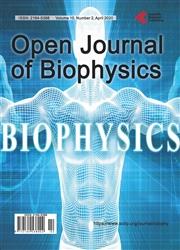Electrostatic Mechanism for Depolymerization-Based Poleward Force Generation at Kinetochores
引用次数: 0
Abstract
Experiments implicating bound volume positive charge at kinetochores interacting with negative charge at microtubule free ends have prompted our calculation of the force at kinetochores for chromosome poleward motility during mitosis. We present here a corroborating force calculation between positively charged Hec1 tails in kinetochores and negatively charged C-termini at microtubule free ends. Based on experimentally-known charge magnitudes on Hec1 tails and C-termini at microtubule free ends, an ab initio calculation of poleward (tension) force per microtubule that falls within the experimental range is demonstrated. Due to the locations of C-termini charges on concave sides of splaying microtubules, this attractive force between subsets of low curvature splaying microtubule protofilaments C-termini eventually fails for subsets of protofilaments with more pronounced curvature, thus generating poleward force as microtubules depolymerize in a dynamic coupling, as observed experimentally. The mechanism by which kinetochores establish and maintain a dynamic coupling to microtubules for force production during the complex motions of mitosis remains elusive, and force generation at kinetochores has emerged as a signature problem in chromosome motility. In agreement with experiment, two separate calculations show that attractive electrostatic interactions over nanometer distances account for poleward chromosome forces at kinetochores.基于解聚的着丝点极性力产生的静电机制
实验表明,着丝点上的结合体积正电荷与微管自由端的负电荷相互作用,促使我们计算有丝分裂过程中着丝点上的力对染色体极性运动的影响。我们在此提出了一个确证力计算在带正电的Hec1尾部和带负电的c末端在微管自由端。基于实验已知的Hec1尾部和微管自由端c末端的电荷量,证明了在实验范围内的每个微管的极性(张力)力的从头计算。实验观察到,由于c端电荷位于微管的凹侧,低曲率的微管原丝亚群之间的吸引力c端最终对曲率更大的微管原丝亚群失效,从而在微管动态耦合解聚过程中产生极性力。在有丝分裂的复杂运动中,着丝点如何建立并维持与微管的动态耦合以产生力的机制尚不清楚,而着丝点的力产生已成为染色体运动中的一个标志性问题。与实验一致,两个独立的计算表明,纳米距离上的吸引静电相互作用解释了着丝点上的染色体极性力。
本文章由计算机程序翻译,如有差异,请以英文原文为准。
求助全文
约1分钟内获得全文
求助全文

 求助内容:
求助内容: 应助结果提醒方式:
应助结果提醒方式:


